
About UsThe Numismatic Bibliomania Society is a non-profit organization promoting numismatic literature. For more information please see our web site at coinbooks.org SubscriptionsThose wishing to become new E-Sylum subscribers (or wishing to Unsubscribe) can go to the following web page link MembershipThere is a membership application available on the web site Membership Application To join, print the application and return it with your check to the address printed on the application. Membership is only $15 to addresses in the U.S., $20 for First Class mail, and $25 elsewhere. For those without web access, write to: David M. Sundman, Secretary/TreasurerNumismatic Bibliomania
Society AsylumFor Asylum mailing address changes and other membership questions, contact David at this email address: dsundman@LittletonCoin.com SubmissionsTo submit items for publication in The E-Sylum, just Reply to this message, or write to the Editor at this address: whomren@coinlibrary.com
BUY THE BOOK BEFORE THE COINYou won't regret it! |
- WAYNE'S WORDS: THE E-SYLUM JUNE 19, 2011
- NEW BOOK: A GUIDE BOOK OF CANADIAN COINS AND TOKENS
- NEW BOOKS: NEW TITLES FROM MONETA
- NEW BOOK: TEN DAYS TO MADNESS
- NUMISMATIC BOOKIE COLUMN DEBUTS IN COIN WORLD
- ANS LIBRARY SEEKS DONATIONS IN MEMORY OF F. GORDON FROST
- U.S. MINT PRODUCES MEDALS FOR 10TH ANNIVERSARY OF SEPTEMBER 11
- MORE ON THE ANS' UTE CHIEF'S LIFE-SAVING LINCOLN PEACE MEDAL
- COINAGE COIN SHOP ADS CIRCA 1965
- QUERY: THE JOURNAL-EXAMINER TRANSCONTINENTAL YELLOW FELLOW MEDAL
- NOTES FROM E-SYLUM READERS: JUNE 19, 2011
- MORE ON AMERICAN COINS IN THE SHORTHOUSE COLLECTION
- URSULA KAMPMANN VISITS THE STUTTGART MINT
- QUERY: $50 CHINESE "PRACTICE NOTE"
- THE SCIENTIST OF THE BANK OF CANADA
- ANNAPOLIS COIN FIND: SUPERNATURAL PROTECTION?
- 1870-CC DOUBLE EAGLE OFFERED BY BONHAMS & BUTTERFIELDS
- ABOUT THOSE FAKE BANKNOTES IN THE TOILET...
- FEATURED WEB PAGE: SLAVE BADGES BOOK
WAYNE'S WORDS: THE E-SYLUM JUNE 19, 2011

Among our new subscribers this week are Frank Crowe, courtesy of Howard A. Daniel III, and Kathy Lawrence of Heritage. Welcome aboard! We now have 1,430 email subscribers, plus 147 followers on Facebook.
This week we open with word of five new numismatic titles and a new COIN World column on numismatic literature. Other topics include September 11 medals, the Stuttgart Mint, Chinese "Practice Money" and an 1870-CC Double Eagle.
To learn about the Slave Badges, Yellow Fellows, and a lost fortune in Bechtler Gold coins, read on. Have a great week, everyone!
Wayne Homren
Numismatic Bibliomania Society
NEW BOOK: A GUIDE BOOK OF CANADIAN COINS AND TOKENS
Canadian Coins and Tokens
Marvel at the Treasures of Our Northern Neighbor
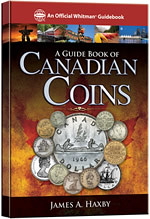 An informal poll in early 2011 suggests that more than 40% of U.S. coin collectors also collect Canadian coins.
This comes as no surprise to enthusiasts such as award-winning researcher James A. Haxby, a numismatist known
throughout the hobby community as a distinguished expert on Canadian coinage. Now, Dr. Haxby has teamed up with
Whitman Publishing to create the definitive price guide and reference book on the coins and tokens of Canada,
from colonial times to the present.
An informal poll in early 2011 suggests that more than 40% of U.S. coin collectors also collect Canadian coins.
This comes as no surprise to enthusiasts such as award-winning researcher James A. Haxby, a numismatist known
throughout the hobby community as a distinguished expert on Canadian coinage. Now, Dr. Haxby has teamed up with
Whitman Publishing to create the definitive price guide and reference book on the coins and tokens of Canada,
from colonial times to the present.
Who will be interested in the Guide Book of Canadian Coins and Tokens?
- beginning to intermediate collectors of Canadian coins
- advanced Canadian specialists who want a well-laid-out single-source reference for mintages,
- specifications, and other technical data
- token collectors looking for an expert guide to Canadian colonial and provincial pieces
- U.S. collectors who want to learn more about closely related Canadian coinage
- world-coin collectors building a type set or more advanced collection of Canadian coins
- new hobbyists and investors attracted to Canadian coins by the recent rise in gold and silver
- casual collectors and travelers with unidentified Canadian coins and tokens, curious about their history and values
Call it the "Red Book with a Canadian accent"—the Guide Book of Canadian Coins and Tokens uses the same familiar format, layout, and design as the hobby's best-selling annual price guide, Whitman's Guide Book of United States Coins (the "Red Book," now in its 66th edition). Coin collectors know and love the Red Book; more than 22 million copies have been sold since the first edition. We're confident that the Guide Book of Canadian Coins and Tokens will be just as popular with active collectors.
Stay tuned for more information.
To read the complete article, see: Canadian Coins and Tokens (www.whitmanbooks.com/Default.aspx?Page=55&HTMLName=ReviewUpcoming_0611)
NEW BOOKS: NEW TITLES FROM MONETA
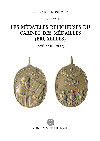
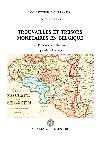
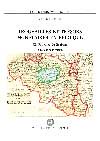
The last volumes of the Moneta Collection are now available
# 125, F. Steyaert, Les médailles religieuses du Cabinet des Médailles (Bruxelles) (XVIe– XVIIIe siècle), 2011, 106 pages ISBN 978-90-77297-93-3; € 45
# 126, J.-L. Dengis, Trouvailles et trésors monétaires en Belgique, X. Province du Hainaut, Les monnaies romaines, 2011, 400 pages. ISBN 978-90-77297-94-0; € 75
# 127, J.-L. Dengis, Trouvailles et trésors monétaires en Belgique, XI. Province du Brabant, Les monnaies romaines, 2011, 120 pages. ISBN 978-90-77297-95-7; € 45
Three other volumes are now in print and will be available in September
# 128, Documents and Studies on 19th c. Monetary History, France, Republication of Ministère des Finances, Documents relatifs à la question monétaire (Paris, 1857), G. Depeyrot, ed., 2011, IV + 6 + 154 + 4* p.; € 50
# 129, Documents and Studies on 19th c. Monetary History, France, Republication of Ministère des Finances…, Conseil Supérieur du Commerce, … Enquête sur la question monétaire (Paris, 1872), Volume I, G. Depeyrot, ed., 2011, IV + 2 + XVI + 768 + 2* p.; € 125
# 130, Documents and Studies on 19th c. Monetary History, France, Republication of Ministère des Finances…, Conseil Supérieur du Commerce…, Enquête sur la question monétaire (Paris, 1872), Volume II, G. Depeyrot, ed., 2011, IV + 2 + IV + 584 + 2* p.; € 100
Information and orders on Moneta ( www.moneta.be )
NEW BOOK: TEN DAYS TO MADNESS
Jamie Clifford, author of Double Daggers has a new numismatic fiction book coming out. He writes:
I have a new book coming out in the Fall titled Ten Days To Madness. There is a numismatic theme. The lead character is trying to discover a hidden fortune in Bechtler Gold coins. The Bechtler Coins were a territorial mint before that operated in North Carolina during the mid 1800's. Legend has it that the last Bechtler disappeared while transporting a large amount of the gold. Neither he nor the gold have ever been discovered. Ten Days To Madness may answer what happened to that last shipment of Bechtler Gold Coins.
 Only Charlie Parker knows that his image as a successful, well-respected family man is a complete lie
and with his life collapsing around him he travels to the secluded mountain house that has been owned
by his family for generations. Hidden in his father's library Charlie unearths a bizarre diary that claims
a rogue tribe of Cherokee Indians stole a fortune in gold coins before the Civil War and hid the treasure
in an ancient burial cave in a remote part of the Appalachian Mountains.
Only Charlie Parker knows that his image as a successful, well-respected family man is a complete lie
and with his life collapsing around him he travels to the secluded mountain house that has been owned
by his family for generations. Hidden in his father's library Charlie unearths a bizarre diary that claims
a rogue tribe of Cherokee Indians stole a fortune in gold coins before the Civil War and hid the treasure
in an ancient burial cave in a remote part of the Appalachian Mountains.
Compelled by forces he doesn't understand, Charlie embarks upon a self-destructive march to uncover the truth as he discovers his family's darkest secrets. His ancestor's heinous crimes force Charlie to face the demons unleashed by his family from so long ago and he is haunted by nightmares, tormented by a strange man claiming ownership of the diary and terrorized by Cherokee spirits known in Indian mythology as The Nunnehi. The horrifying encounters send Charlie spiraling into an alcohol fueled frenzy to find the Cherokee gold, no matter the cost.
Does the gold exist? Are the bizarre events really happening to Charlie or has his mind finally collapsed under the pressures of mental illness, alcohol abuse and a failed business? Those questions linger in the reader's mind until the final page as Charlie battles internal demons and external monsters to discover the truth about himself, and the legend of the Cherokee Gold.
For more information, see: James R. Clifford (www.jrclifford.com/order.html)
NUMISMATIC BOOKIE COLUMN DEBUTS IN COIN WORLD
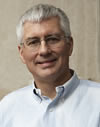 I have achieved a lifelong ambition of becoming a bookie--a Numismatic Bookie--which will be the title of my new monthly column for Coin World. I pitched editor Beth Deisher on doing such a column, aimed at collectors and potential collectors of numismatic literature, as opposed to scholars. I hope to bring a few new collectors into the fold thereby, and to popularize the hobby in general. Beth has been very supportive of the concept, and agreed to give it a go in the regular issues of Coin World.
I have achieved a lifelong ambition of becoming a bookie--a Numismatic Bookie--which will be the title of my new monthly column for Coin World. I pitched editor Beth Deisher on doing such a column, aimed at collectors and potential collectors of numismatic literature, as opposed to scholars. I hope to bring a few new collectors into the fold thereby, and to popularize the hobby in general. Beth has been very supportive of the concept, and agreed to give it a go in the regular issues of Coin World.
The first column will appear in the June 27 issue. It has been announced in the online version of Coin World, and will soon be announced in the corresponding print edition. I'd appreciate receiving any ideas E-Sylum readers have for column subjects. I can talk about any literature-related item I want--as long as I don't talk about it for more than 600 words!
My aim in writing The Numismatic Bookie is to introduce potential collectors and beginning collectors of numismatic literature to the fascinating and fun (hence the playful title) world of collecting coin books, magazines, auction catalogs, price lists and ephemera. The column won't break new ground in research--The Asylum and The E-Sylum already do a great job of that--but I hope it will attract some new collectors to a truly wonderful hobby.
To read the COIN World column announcement, see: Orosz column 'Numismatic Bookie' debuts (www.zillionsofcoins.com/articles/orosz-column-numismatic-bookie-debuts/)
SALE 13 IS NOW CLOSED
A HEARTY THANK YOU! TO ALL OURBIDDERS AND CONSIGNORS
PRICES REALIZED ARE POSTED ON OUR WEB SITE NOW!
PLEASE CHECK OUR WEB SITE FOR HIGHLIGHTS OF OUR NEXT SALE
OCTOBER 1, 2011 - MAIL BID SALE NO. 14
DAVID SKLOW – FINE NUMISMATIC BOOKS
P.O. BOX 6321
COLORADO SPRINGS, CO 80934
TEL: (719) 302-5686
FAX: (719) 302-4933
numismaticbooks@aol.com
www.finenumismaticbooks.com
ANS LIBRARY SEEKS DONATIONS IN MEMORY OF F. GORDON FROST
American Numismatic Society Librarian Elizabeth Hahn writes:
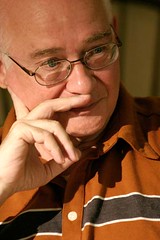 On March 2, 2011, Gordon Frost, a Fellow and donor of the American Numismatic Society unexpectedly passed away at the age of 75.
At the suggestion and with the active support of his devoted wife of almost 45 years, Rosalie, the American Numismatic Society wishes to commemorate Gordon Frost's life-long passion for numismatics and books by naming a section of the Harry W. Bass, Jr. Library after him.
On March 2, 2011, Gordon Frost, a Fellow and donor of the American Numismatic Society unexpectedly passed away at the age of 75.
At the suggestion and with the active support of his devoted wife of almost 45 years, Rosalie, the American Numismatic Society wishes to commemorate Gordon Frost's life-long passion for numismatics and books by naming a section of the Harry W. Bass, Jr. Library after him.
The library contains a number of books devoted to the study of nautical archaeology including shipwreck finds and sunken treasure, which were frequently consulted by Gordon who was working on a book on the literature of sunken treasure. The shelves that contain these books will bear a label "In Memory of Fredric Gordon Frost." Funds from all shelf naming donations help support the library and its ongoing projects.
It is the aim of the Society to ultimately raise $10,000 in order to include Gordon's name not only on the shelving section, but also on the Library Benefactor wall inside the John J. Ford, Jr. Reading Room of the Library.
If you have any questions about donating to this drive or the ANS, please contact Megan Fenselau (212-571-4470, ext. 117).
Thank you for your support. Full website, including a nice obituary by ANS Curator Robert Wilson Hoge, on the website here: Donations in memory of F. Gordon Frost (1935 - 2011). (numismatics.org/Library/Frost)
U.S. MINT PRODUCES MEDALS FOR 10TH ANNIVERSARY OF SEPTEMBER 11
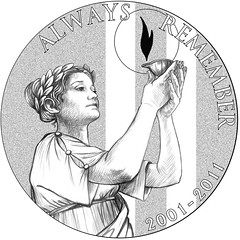
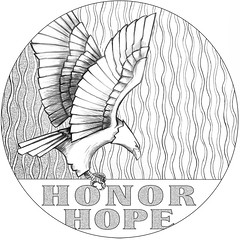
The United States Mint today announced that it will begin accepting orders for the 2011 September 11 National Medal on June 20, 2011, at noon Eastern Time (ET). Public Law 111-221, the "National September 11 Memorial & Museum Commemorative Medal Act of 2010," authorizes the minting and issuance of up to two million one-ounce silver medals in commemoration of the 10th anniversary of the September 11, 2001, terrorist attacks on the United States and the establishment of the National September 11 Memorial & Museum at the World Trade Center.
The proof quality medal's obverse (heads side) design features Lady Liberty holding the Lamp of Remembrance. Behind her are beacons of light stretching skyward. Lady Liberty, the lamp and the light symbolize not only the immeasurable loss on that fateful day, but also the resiliency and triumph of those who persevered. Inscriptions are ALWAYS REMEMBER and 2001 - 2011. It was designed by United States Mint Artistic Infusion Program Master Designer Donna Weaver and sculpted by United States Mint Sculptor-Engraver Phebe Hemphill.
The medal's reverse (tails side) design depicts an eagle, symbolizing the strength of the survivors, the families and the Nation, against a backdrop of cascading water. The flowing water is emblematic of peace, serenity, healing and the continuity of life. Inscriptions are HONOR and HOPE. It was designed by Weaver and sculpted by United States Mint Sculptor-Engraver Joseph Menna.
To the extent possible, approximately one-half of the medals will be struck at the United States Mint at West Point (featuring the "W" mint mark) and one-half at the United States Mint at Philadelphia (featuring the "P" mint mark), with customers able to purchase one or both options. There is no household order limit for this product.
The introductory price of $56.95 each will be in effect from June 20 through August 18, 2011, at 5 p.m. ET, when the regular price of $66.95 each goes into effect. Both prices include a $10 surcharge, authorized to be paid to the National September 11 Memorial & Museum, a private not-for-profit organization overseeing the design and funding of the memorial and museum at the World Trade Center site. The funds will support the museum's operations and maintenance once it is completed. To learn more about the National September 11 Memorial & Museum, please visit http://www.911memorial.org/.
Orders placed during the introductory pricing period will include a complimentary 8" x 10" document, suitable for framing, showcasing the artwork for the medal's designs, descriptions of the designs and the signature of the Acting Director of the United States Mint. The complimentary document will be shipped separately at the same time as the medals.
Orders will be accepted at http://www.usmint.gov/catalog or at 1-800-USA-MINT (872-6468). Hearing- and speech-impaired customers with TTY equipment may order by calling 1-888-321-MINT (6468). A shipping and handling fee of $4.95 will be added to all domestic orders. Orders for the medal will begin shipping in September.
To read the complete article, see: United States Mint to Offer 2011 September 11 National Medal for Sale June 20 www.usmint.gov/pressroom/?action=press_release&id=1255)
An article in Numismatic News notes:
Tom Jurkowsky, Mint director of public affairs, says the 9/11 medals are struck on the same 1 ounce blanks provided by Sunshine that are used for the silver American Eagle coins. As a consequence, the medal will have the same diameter as the coin and .999 fineness, but the edge will be plain rather than reeded.
To read the complete article, see: 9/11 medal ready (www.numismaticnews.net/article/911-medal-ready)
MORE ON THE ANS' UTE CHIEF'S LIFE-SAVING LINCOLN PEACE MEDAL
Dan wrote:
"It's not quite a "life-saving coin" but there's a medal with an interesting story. The ANS owns a silver Lincoln peace medal which was supposedly worn by a Ute chief when he was shot. Rather than seeing the medal as the reason for his survival, he saw it as being responsible for his being shot. The ANS has owned the medal since 1917, a gift from J. Sanford Saltus.
Web site visitor Dave Lanara wrote:
I discovered the E-Sylum story on the American Numismatic Society's Lincoln peace medal with the Indian/bullet and was stunned beyond belief. The reason is that I have been searching for this medal for over twenty years. It was part of a huge number of artifacts that belonged to a Denver businessman who wrote an account of his acquisition of the medal in the 1870s.
Dave wrote back recently:
I have found a photo of chief Honko wearing the Lincoln medal. The right image was a photo owned by J.P. Lower of Honko, left standing image was recently found in a catalog marked unknown Indian, but it is clearly the same man. The standing photo shows Honko wearing the medal! He was known for his long, thick war braids. This photo must have been taken before his decision to sell the medal.
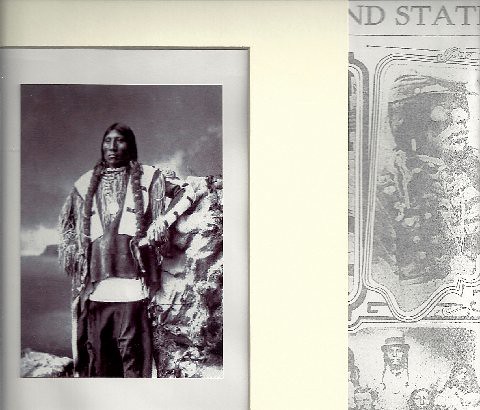
To read the earlier E-Sylum articles, see:
HEAP BAD MEDICINE: UTE CHIEF'S LIFE-SAVING LINCOLN PEACE MEDAL
(www.coinbooks.org/esylum_v09n33a28.html)
MORE ON THE ANS' UTE CHIEF'S LIFE-SAVING LINCOLN PEACE MEDAL
(www.coinbooks.org/esylum_v10n16a21.html)
COINAGE COIN SHOP ADS CIRCA 1965
Dave Lange writes:
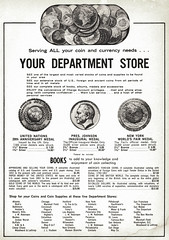 From time to time the subject of department store coin franchises has come up in The E-Sylum, with readers supplying their fond recollections. In the course of scanning old coin album ads for my next book, I came across these two ads from COINage Magazine in 1965-66. The first lists various department stores around the country that had coin departments, and these were presumably the Friedberg franchises.
From time to time the subject of department store coin franchises has come up in The E-Sylum, with readers supplying their fond recollections. In the course of scanning old coin album ads for my next book, I came across these two ads from COINage Magazine in 1965-66. The first lists various department stores around the country that had coin departments, and these were presumably the Friedberg franchises.
The second ad encourages entrepreneurs to avail themselves of a Midas Coin Center franchise. All one had to do was select a location, and Midas would supply everything needed to start a coin shop, including the coins. I can't think of a worse time for someone to open a coin shop than the post-1964 coin market depression that lasted for several years. There must have been shops closing all over the country!
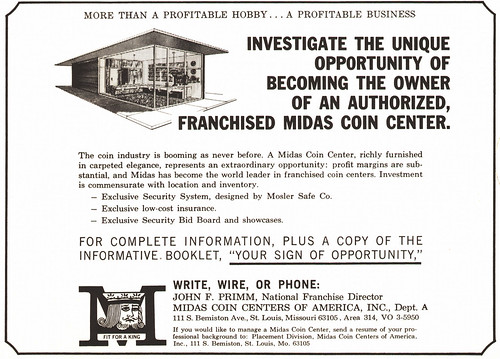
QUERY: THE JOURNAL-EXAMINER TRANSCONTINENTAL YELLOW FELLOW MEDAL
Dave Lanara writes:
I have a Journal Examiner transcontinental Yellow Fellow medal struck in silver. Photos attached, along with an early tin type of a bicycle rider wearing a light colored cap. He may actually be a "Yellow fellow". Are these a common?

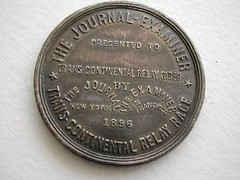
THE BOOK BAZARRE
NOTES FROM E-SYLUM READERS: JUNE 19, 2011
George Fitzgerald
Regarding George Fitzgerald, Pete Smith writes:
I would like to react to the comment that George always wore a baseball-style cap. I recall one of those caps had "PING" across the front. Perhaps some of those baseball caps were actually golf caps.
To read the earlier E-Sylum article see: REMEMBERING NBS MEMBER GEORGE FITZGERALD (www.coinbooks.org/esylum_v14n24a10.html)
Quick Binding By Kolbe & Fanning
Len Augsburger writes:
The Kolbe/Fanning sale was held June 2 and only 11 days later (of which two were Sundays) I received in the mail the hardbound catalog w/PRL bound in. This has got to be a numismatic record.
San Francisco Mint Gold Ledger Books
Len also notes:
Following up on the discussion about Mint ledgers which appeared on ebay a few weeks back, some more have come to light.
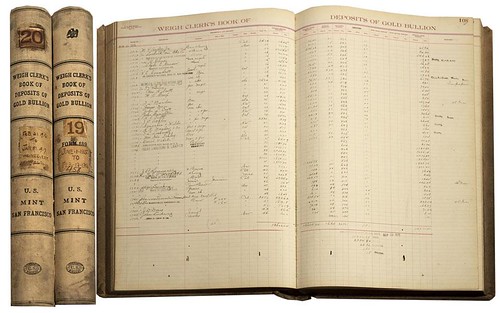
Lot of 2. These ledgers show ingot submissions from the western states. Entries include deposits from Alaska, Colorado, Nevada, and California. Of particular interest are the California submissions from the Yellow Aster Mining Company. Both books show Deposits of Gold Bullion (printed at the top of each page) written in manuscript by the clerk at the San Francisco Mint. Weigh Clerk's Book of Deposits of Bullion "#19" dates June 1, 1915 to February 19, 1916. Book 2 "#20" dates February 21, 1916 to January 31, 1917. Book 1 has slight wear including 6 worm holes through the bottom of the sheets and boards. Book 2 has additional worm holes through the boards and lower portions of the ledger sheets. Both are bound in white covers and were bound by the U.S. Government Bindery. Spines are tight and the sheets are legible and clean otherwise. Both 13" x 18".
To read the complete article, see: CA - San Francisco,1915-1917 - U.S. Mint Ledgers (liveauctions.holabirdamericana.com/CA-San-Francisco-1915-1917-U-S-Mint-Ledgers_i10680091)
MORE ON AMERICAN COINS IN THE SHORTHOUSE COLLECTION
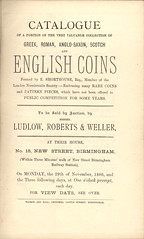 [Shorthouse, E.]. CATALOGUE OF A PORTION OF THE VERY VALUABLE COLLECTION OF GREEK, ROMAN, ANGLO-SAXON, SCOTCH AND ENGLISH COINS FORMED BY E. SHORTHOUSE, ESQ., MEMBER OF THE LONDON NUMISMATIC SOCIETY:—EMBRACING MANY RARE COINS AND PATTERN PIECES, WHICH HAVE NOT BEEN OFFERED TO PUBLIC COMPETITION FOR SOME YEARS. Birmingham: Ludlow, Roberts & Weller, November 29-December 2, 1886. vi, (2), 63, (1) pages, 901 lots. Pale yellow cloth, lettered in black, original printed yellow wrappers bound in, contents once folded. Fine. (250.00)
[Shorthouse, E.]. CATALOGUE OF A PORTION OF THE VERY VALUABLE COLLECTION OF GREEK, ROMAN, ANGLO-SAXON, SCOTCH AND ENGLISH COINS FORMED BY E. SHORTHOUSE, ESQ., MEMBER OF THE LONDON NUMISMATIC SOCIETY:—EMBRACING MANY RARE COINS AND PATTERN PIECES, WHICH HAVE NOT BEEN OFFERED TO PUBLIC COMPETITION FOR SOME YEARS. Birmingham: Ludlow, Roberts & Weller, November 29-December 2, 1886. vi, (2), 63, (1) pages, 901 lots. Pale yellow cloth, lettered in black, original printed yellow wrappers bound in, contents once folded. Fine. (250.00)
This obscure and seldom-offered sale features E. Shorthouse's famous comments "To American Coin Collectors." Manville & Robertson term the catalogue "amusing" and the man "contentious." After a lengthy description of a Queen Anne BELLO • ET• PACE pattern farthing in copper, the catalogue notes: "Unless a starting bid of £15 is made, this lot will be withdrawn, on the ground, that if an important English coin of which only three are known is not worth £15, it is worth nothing."
According to Manville & Robertson, the coin brought £19.7.6 but they also note that "Dealers Spink, Thomas, and Verity, bought-in more than a third of the lots. These were offered in London the next year and some again in 1888." In the Appendix, Shorthouse apologizes for the "prejudicial statement (lot 228) that the youthful Emperor Julian II. had a ‘Young Bear Head," noting that "‘Young' as distinguished from…‘mature'…and ‘Bare' head as distinguished from ‘laureated' was all that was intended."
The sale featured relatively few lots of American interest, mostly colonial coins sold in lots. Shorthouse's interest in the field, however, was intense and his lengthy comments "To American Coin Collectors" are filled with fascinating observations. He offers a reward for information leading to the return of "a valuable set of ‘Lord Baltimore' silver money, consisting of the Shilling, Sixpence, and rare Groat, in unusually fine condition," promising the informant "a P.O. order for £5, also a beautiful U.S. 1796 cent, with the cap, in absolutely Mint condition, for his trouble."
He then recounts the experiences of "Three Years' American Coin Collecting in England." "As late as 1882 U.S. coins were to be picked up in England very cheaply, now they very seldom occur. Our ignorance of them was, and still is, in most cases, profound." He notes that "A lovely 1794 dollar stood for two years in the ‘Bureau de Change' window, Charing Cross Station, London, staring at the British public; the writer could have had it a dozen times at £1. Finally swept off by good Mr. Randall on his last visit to the British Isles."
Though not cited in the bibliography, this text is doubtless the source of the pedigree in Breen's Encyclopedia of the Nova Constellatio 100 bit to "T. F. Cloud, Pawnbroker, 207 High Holborn, London." Shorthouse acquired the unique pattern for two shillings, three pence. "Knowing about as much about it as the average Christian knows about the Origin of Evil, he forwarded it to his friend Mr. W. Elliot Woodward…with whom an English gentleman can deal with safety and pleasure."
Originally offered in the Addenda to Woodward's 1885 73rd sale with a $550 reserve, it finally sold for $272 in the 1886 83rd sale. Woodward's account of the unique pattern is at variance with Shorthouse ("It has existed for an unknown period in the collection of an old numismatist in Scotland, whose recent death led to the dispersion of his cabinet by auction.").
Shorthouse goes on to recount with pride the acquisition of a number of other "Plums," including" "An ‘Ameri" cent., in mint condition, another fine; a 1795 cent., thick lettered edge, in absolutely uncirculated condition…a 1796, with cap, in equal condition, resembles a proof…two fine 1804 cents…a 1799 cent. in mint state was just missed at 7s. 6d.…Baltimore money (not yet stolen); rows of ‘pine' and ‘oak tree' money, some very fine;" etc.
He notes "In Conclusion" that "American coins, compared with those of other nations, appear to the writer to be unquestionably the most uninteresting series in the world." Then he suggests "that some American gentleman, wishing to acquire a very fine U. S. collection, had better come over next summer (1887)…and take away the collection to that Great and Amazing Country…to which it properly belongs…"
To read the earlier E-Sylum article, see: MORE ON AMERICAN COINS IN THE SHORTHOUSE COLLECTION (www.coinbooks.org/esylum_v14n24a23.html)
URSULA KAMPMANN VISITS THE STUTTGART MINT
CoinsWeekly received an invitation for a visit to the Stuttgart Mint. We needn't be asked twice. After all, that mint, which is identified by the F mark on German coins, has a tradition that goes back more than 600 years. It was in 1374 that Charles IV granted Eberhard II, Count of Wuerttemberg, the right to of mint coins. Since 1967, The Stuttgart Mint is situated in a modern building in the Bad Cannstatt, a district of Stuttgart. Anyone interested in visiting the mint is required to show his ID card and to remove any hard cash from his pockets. Anyone leaving the building – whether director or apprentice –, gets checked.
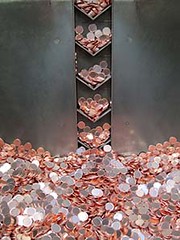

To read the complete article, see: A visit to the Stuttgart Mint (www.coinsweekly.com/en/News/4?&id=640)
QUERY: $50 CHINESE "PRACTICE NOTE"
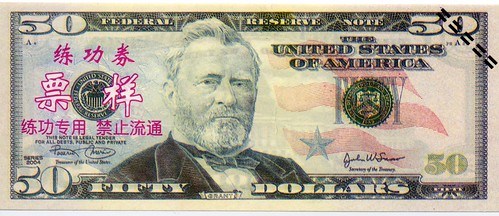

THEY ARE A COPY OF A U.S. $50 BILL.FEATURING GRANT ON THE OBVERSE. THE CAPITAL ON THE REVERSE. THEY ARE USED TO TEACH BANK TELLERS IN CHINA. THE CHARACTERISTICS OF THE U.S. CURRENCY. THEY ARE CALLED PRACTICE MONEY. THEIR SIZE IS SIMILAR TO THE REAL THING. JUST THE PRINT QUALITY IS NOT THAT OF THE REAL NOTES. I BELIEVE THEY PRINTED ON A PHOTO OFFSET PRESS. THE DO NOT APPEAR TO BE PHOTO COPIED.
This is what the printer of this money says are its usage. Her exact quote " Hello dear friends: Quality of the item is very good, my husband is the senior management of the Bank of China to provide Canada, France, Japan, Hong Kong, Germany, Italy, Switzerland, Australia, the United States, the euro and other countries of the different denominations and various banks in China."
IF THIS IS TRUE OR NOT. I DO NOT KNOW. WHAT I DO KNOW IS THAT THEY MAKE AN INTERESTING NOVELTY NOTE.
"COLLECTING RARE COINS FOR PLEASURE AND PROFIT"
THE SCIENTIST OF THE BANK OF CANADA
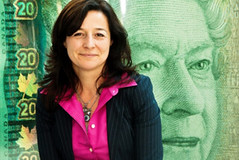 At her interview with the Bank of Canada in 2005, Andrea Firth was asked to give a 30-minute presentation about what she thought a scientist would do at a central bank.
At her interview with the Bank of Canada in 2005, Andrea Firth was asked to give a 30-minute presentation about what she thought a scientist would do at a central bank.
Ironically, now that she's actually held the position — her official title is banknote scientific adviser — for the past half dozen years, she has to be circumspect about revealing the details of what she does.
That's because it's her job to make counterfeiters' jobs more difficult; a cat-and-mouse game where by inventing and implementing security features on Canadian paper currency, the gap between real and fake is made as wide as possible, so that the people and machines that handle money can easily recognize the bogus bills.
"Our job is to work to stay ahead of counterfeiting and counterfeiters," she says, "and that involves chemistry, physics, biology and psychology, in different ways.
"We look to see what the counterfeiters do, what they have available, what they could have available, what we think they will make use of and how they would make use of it. If the counterfeits are getting close to the banknotes, then we start looking at solutions, at what we can buy to put on the banknotes to make them more secure."
And when one technology no longer deters counterfeiters, it's Firth's job to come up with something that will. With holograms becoming increasingly common, for example, some analysts are now touting nanoholes — tiny holes which in butterfly wings block out certain wavelengths of light and produce their familiar iridescence — as the next anti-counterfeiting measure.
Mum's the word, though, on what new technologies will be used in Canada's new paper currency, which is officially being announced Monday and will roll off the presses with the $100-bill in the fall. The only information available so far about the new series is that it will be printed on a plastic polymer, as opposed to the cotton-based currency now in circulation. The polymer, while more difficult to counterfeit, will also more than double the life expectancy of bills. Each of the 840 million $20-bills — the most popular denomination — now in circulation are expected to last three years. The polymer $20s will last seven and a half.
"A security feature that's going out into circulation in November 2011 came from me, came from a concept in my mind," she adds. "What we've worked on, every Canadian is going to touch. That's pretty cool.
"If a security feature that started out on my drafting board ends up on a banknote, I'll be doing a happy dance and drinking champagne."
To read the complete article, see: The Bank Scientist (www.ottawacitizen.com/news/Bank+Scientist/4958428/story.html)
ANNAPOLIS COIN FIND: SUPERNATURAL PROTECTION?
When James Holliday, an African-American who was born a slave but died an Annapolis homeowner, gathered for meals with his family in their brick home just off State Circle in the late 19th century, they dined on fine dishware — each plate with its own ornate pattern or crisp white finish.
With what was then considered a prestigious job as a messenger for the superintendent at the U.S. Naval Academy, Holliday could afford to buy his family fancy plates in accordance with Victorian etiquette as relayed in books and newspapers.
But unique to the middle-class, African-American experience in Annapolis, researchers say, was the practice of buying plates of varying patterns — not an entire set of dishware in a single design — perhaps for financial reasons or perhaps as a way of putting an individual stamp on the table.
Archaeologists from the University of Maryland have painstakingly excavated Holliday's plates, bottles and other items — including an 18th-century coin worn as a good-luck charm — from the backyard and basement of the East Street home in recent months.
Their work, at the Holliday House and another historic home where African-Americans and later Filipino immigrants lived, concluded Thursday. Now the team will move on to the meticulous process of cleaning, cataloging and studying the items in terms of their historical context and telling this story of Annapolis.
"What we've found here are really some rare finds," said Mark P. Leone, an archaeologist at the University of Maryland, College Park. "They were middle-class and free. That is rare and not frequently explored in Maryland."
Perhaps most interesting, said Leone, is a Spanish coin from 1789. The silver coin has a small, crudely punched hole, indicating that it was worn as a pendant, Leone said, a religious practice thought to provide supernatural protection that can be traced to West African traditions.
To read the complete article, see:
Annapolis findings illuminate 19th-century African-American life
(www.baltimoresun.com/news/maryland/anne-arundel/bs-md-ar-
annapolis-archeological-dig-20110616,0,1263222.story)
1870-CC DOUBLE EAGLE OFFERED BY BONHAMS & BUTTERFIELDS
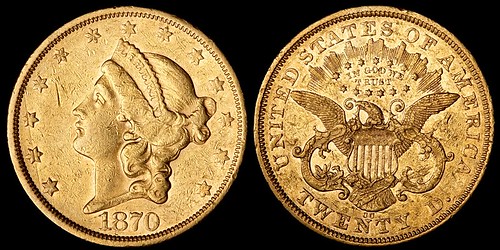
Bonhams & Butterfields announces its sale on September 4, 2011 of gold coins from the Estate of Hellen and Charles Mapes, of Reno, NV. The eponymous Collection, once owned by the famed hotel and casino mogul Charles Mapes, includes a rarely seen, high grade 1870-CC Liberty Double Eagle coin. This date and mint are well known to numismatists as the top Carson City rarity in the Liberty Double Eagle series. In fact, it is the rarest of all CC gold coinage.
This particular coin has been in the Mapes Collection since it was purchased in February of 1961 from the fabled Kreisberg-Schulman Auction of February 16-18, 1961 held at the Waldorf-Astoria Hotel in New York City, and can be considered a "discovery" piece due to the length of time since its last offering 50 years ago. Knowledgeable researchers estimate that approximately 35 to 45 1870-CC $20 coins exist, most in the Very Fine to Extremely Fine grade range. It should be noted there are no Uncirculated (Mint State) examples presently known to either of the major grading services.
Paul Song, Director of the Rare Coins and Bank Notes Department, Bonhams & Butterfields, said of the coin: "We are estimating the Mapes 1870-CC Double Eagle to conservatively be $150,000-$180,000. This year marks the 50th year anniversary of Mr. Mapes' purchase of this ultra-rarity and this example has not seen the light of day for the past 50 years, making this example in effect a coin of the highest importance being offered after a half century in the depths of a safety deposit box."
At the time this coin was brought into Bonhams' offices, the client was unaware that this was in fact a classic rarity, and believed this coin to be the much more common 1870 $20, which is typically estimated between $1,500-2,000.
Song continues: "I really enjoyed looking at this nice old group of coins which had clearly been from an 'old time collection.' I looked at the three 1907 High Relief $20's and the two $50 California so-called slugs before I saw the 1870 $20. It was encased in a very unpretentious looking Capital Plastics holder, but when I flipped the coin over to look at the reverse to determine the condition of the coin, the CC mintmark simply jumped out at me. It was a true surprise, and also for our client.
To read the complete article, see: Newly Rediscovered, Ultra Rare 1870-Cc $20 Gold Coin on the Auction Block (www.artdaily.org/index.asp?int_sec=2&int_new=48312)
ABOUT THOSE FAKE BANKNOTES IN THE TOILET...
Money suspected by bank staff on the Western Isles to be counterfeit has turned out to be the real thing.
One businessman had torn up £20 notes and flushed them down the toilet to stop them getting back into circulation after being told they were fake.
Police asked to investigate the suspect notes three weeks ago said forensics had shown the money was genuine.
The Bank of Scotland said staff had found what they thought were inconsistencies with some notes.
A spokesman added that the notes involved were taken out of circulation.
Northern Constabulary said money handed in to police and found be real would be returned, but added further banknotes still had to be checked.
To read the complete article, see: 'Fake' £20s put down toilet on Western Isles were real (www.bbc.co.uk/news/uk-scotland-highlands-islands-13748436)
FEATURED WEB PAGE: SLAVE BADGES BOOK
This week's Featured Web Page is about a book on Slave Badges. Is anyone familiar with it? Who could write a review?
Slave Badges and the Slave-Hire System in Charleston, South Carolina, 1783-1865 Harlan Greene, Harry S. Hutchins, Jr., with Brian E. Hutchins
The slave-hire system of Charleston, South Carolina, in the 1700s and the 1800s produced a curious object the slave badge. The badges were intended to legislate the practice of hiring a slave from one master to another, and slaves were required by law to wear them. Slave badges have become quite collectible and have excited both scholarly and popular interest in recent years.
This work documents how the slave-hire system in Charleston came about, how it worked, who was in charge of it, and who enforced the laws regarding slave badges. Numerous badge makers are identified and photographs of badges, with commentary on what the data stamped on them mean, are included. The authors located income and expense statements for Charleston from 1783 to 1865, and deduced how many slaves were hired out in the city every year from 1800 on. The work also discusses forgeries of slave badges.
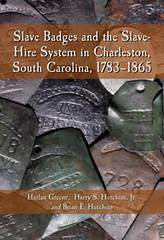
www.slavebadges.com/Book.html
